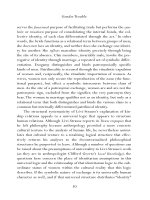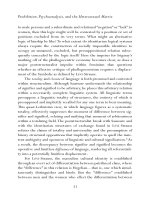GENDER TROUBLE 24
Bạn đang xem bản rút gọn của tài liệu. Xem và tải ngay bản đầy đủ của tài liệu tại đây (20.29 KB, 1 trang )
Preface 1999
when one cannot with surety read the body that one sees, is precisely
the moment when one is no longer sure whether the body encountered
is that of a man or a woman. The vacillation between the categories
itself constitutes the experience of the body in question.
When such categories come into question, the reality of gender is
also put into crisis: it becomes unclear how to distinguish the real from
the unreal. And this is the occasion in which we come to understand
that what we take to be “real,” what we invoke as the naturalized
knowledge of gender is, in fact, a changeable and revisable reality. Call
it subversive or call it something else. Although this insight does not in
itself constitute a political revolution, no political revolution is possible without a radical shift in one’s notion of the possible and the real.
And sometimes this shift comes as a result of certain kinds of practices
that precede their explicit theorization, and which prompt a rethinking of our basic categories: what is gender, how is it produced and
reproduced, what are its possibilities? At this point, the sedimented
and reified field of gender “reality” is understood as one that might be
made differently and, indeed, less violently.
The point of this text is not to celebrate drag as the expression of a
true and model gender (even as it is important to resist the belittling
of drag that sometimes takes place), but to show that the naturalized
knowledge of gender operates as a preemptive and violent circumscription of reality.To the extent the gender norms (ideal dimorphism,
heterosexual complementarity of bodies, ideals and rule of proper and
improper masculinity and femininity, many of which are underwritten
by racial codes of purity and taboos against miscegenation) establish
what will and will not be intelligibly human, what will and will not be
considered to be “real,” they establish the ontological field in which
bodies may be given legitimate expression. If there is a positive normative task in Gender Trouble, it is to insist upon the extension of this
legitimacy to bodies that have been regarded as false, unreal, and unintelligible. Drag is an example that is meant to establish that “reality” is
xxiii









